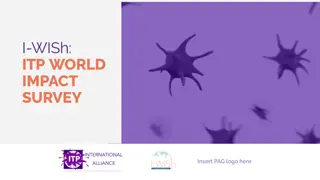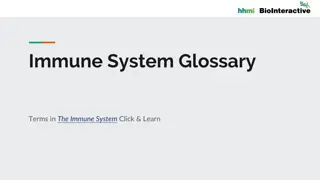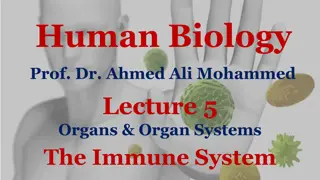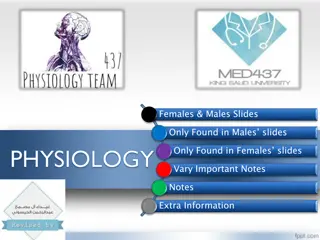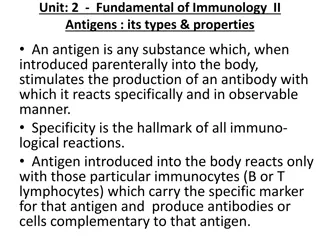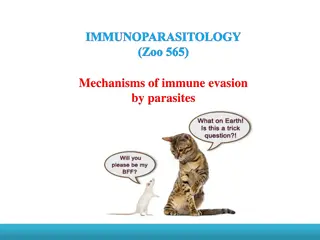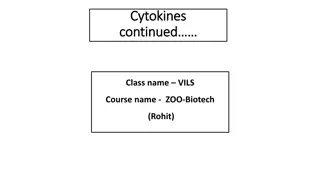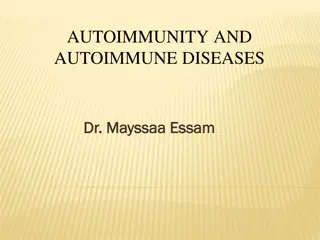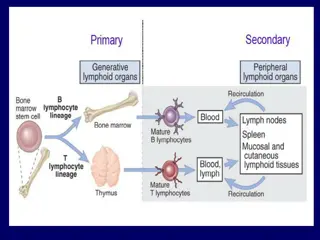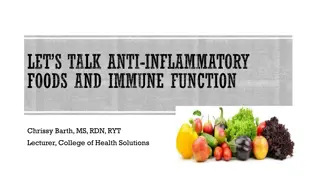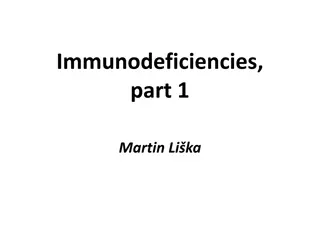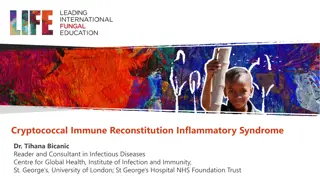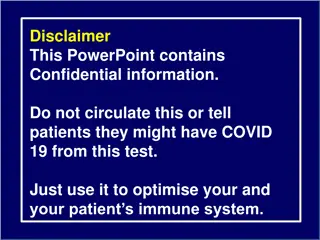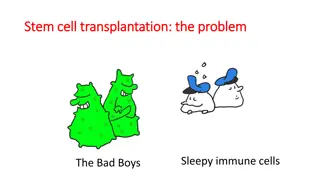Understanding the Importance of the Immune System for Homeostasis
Explore the intricate workings of the immune system, from its component parts and defense mechanisms to the significance of homeostasis maintenance. Discover how non-specific and specific immune responses, phagocytosis, neutrophils, natural killer cells, and interferons play vital roles in protecting the body. Learn about barrier functions like skin, mucosa, tears, and enzymes that prevent infections. Delve into functions like immune surveillance, autotolerance, and defense against infections and immunodeficiencies. Gain insights into how the immune system handles allergies and autoimmune conditions.
Download Presentation

Please find below an Image/Link to download the presentation.
The content on the website is provided AS IS for your information and personal use only. It may not be sold, licensed, or shared on other websites without obtaining consent from the author. Download presentation by click this link. If you encounter any issues during the download, it is possible that the publisher has removed the file from their server.
E N D
Presentation Transcript
Immune system and its importance for homeostasis. Component parts of the immune system and their cooperation. Barrier functions of the human body and defense mechanisms. Non-specific cellular and humoral immune mechanisms. Specific cellular and humoral immune mechanisms. Phagocytosis and its importance for immunity. Neutrophils, their ontogenesis and function. Natural killer cells. Interferons. Characteristics and function.
Immune system and its importance for homeostasis. Component parts of the immune system and their cooperation. Barrier functions of the human body and defense mechanisms. Non-specific cellular and humoral immune mechanisms. Specific cellular and humoral immune mechanisms. Phagocytosis and its importance for immunity. Neutrophils, their ontogenesis and function. Natural killer cells. Interferons. Characteristics and function.
Functions of the immune system Defense (infections) (immunodeficiencies) Immune surveillance (tumors) Autotolerance (autoimmunity) Correct function (allergy)
Immune system and its importance for homeostasis. Component parts of the immune system and their cooperation. Barrier functions of the human body and defense mechanisms. Non-specific cellular and humoral immune mechanisms. Specific cellular and humoral immune mechanisms. Phagocytosis and its importance for immunity. Neutrophils, their ontogenesis and function. Natural killer cells. Interferons. Characteristics and function.
Barrier functions skin mucosa mucus tears enzymes pH flushing of fluids vomiting diarrhea
Immune system and its importance for homeostasis. Component parts of the immune system and their cooperation. Barrier functions of the human body and defense mechanisms. Non-specific cellular and humoral immune mechanisms. Specific cellular and humoral immune mechanisms. Phagocytosis and its importance for immunity. Neutrophils, their ontogenesis and function. Natural killer cells. Interferons. Characteristics and function.
non-specific specific Cellular granulocytes monocytes-macrophages DC, NK cells T lymphocytes Humoral complement antibodies IFN other proteins (CRP,MBL..)
Immune system and its importance for homeostasis. Component parts of the immune system and their cooperation. Barrier functions of the human body and defense mechanisms. Non-specific cellular and humoral immune mechanisms. Specific cellular and humoral immune mechanisms. Phagocytosis and its importance for immunity. Neutrophils, their ontogenesis and function. Natural killer cells. Interferons. Characteristics and function.
Specific immunity - Adaptive in response to antigens (e.g. infectious agents) - Is not innate - T and B lymphocytes, immunoglobulins - Immunological memory
Cooperation between specific and non-specific immunity
Immune system and its importance for homeostasis. Component parts of the immune system and their cooperation. Barrier functions of the human body and defense mechanisms. Non-specific cellular and humoral immune mechanisms. Specific cellular and humoral immune mechanisms. Phagocytosis and its importance for immunity. Neutrophils, their ontogenesis and function. Natural killer cells. Interferons. Characteristics and function.
Process of phagocytosis Migration - diapedesis, chemotaxis Recognition - PAMP, TLR, opsonization (FcR, CR) Ingestion Intracellular degradation (Antigen presentation)
Example of adhezive interactions diapedesis of neutrophils obr.4
Process of phagocytosis Migration - diapedesis, chemotaxis Recognition - PAMP, TLR, opsonization (FcR, CR) Ingestion Intracellular degradation (Antigen presentation)
Immune system and its importance for homeostasis. Component parts of the immune system and their cooperation. Barrier functions of the human body and defense mechanisms. Non-specific cellular and humoral immune mechanisms. Specific cellular and humoral immune mechanisms. Phagocytosis and its importance for immunity. Neutrophils, their ontogenesis and function. Natural killer cells. Interferons. Characteristics and function.
Neutrophils The most prevalent leukocytes (cca 70%) Granulocytes Staining with H&E pink gray Segmented nucleus (2-5 seg.), granules in cytoplasm Active in defense against extracellular microbes
Neutrophils Half-life in circulation cca 12 h. After activation - margination (movement close to vessel wall) rolling (selectins) adhesion to endothelium (integrins) diapedesis (integrins) chemotaxis (movement to the site of inflammation against the concentration gradient of chemotaxins - IL-8, IFN- , C5a) binding to the foreign particle
Neutrophils - phagocytosis Interaction with molecules on the surface of microbes (PAMPs, lectin interactions, TLR binding to some microbial surface structiures) Opsonization (= enhancement of binding of phagocytes to the microbe) with help of Ig, complement components, CRP, MBL
Neutrophils - phagocytosis Engulfing of the microorganism formation of a vesicle (phagosome) fuse with lysosome phagolysosome Formation of phagosome depends on activity of contractile cytoplasmic proteins
Neutrophils intracellular destruction of microorganisms 1/ Oxygen independent systems Substances contained in granules Cathepsin, lysozym hydrolyse of the cell wall of microorganisms Defensins formation of perforations in the microbial membrane
Neutrophils intracellular destruction of microorganisms 2/ Oxygen dependent systems Oxidative burst NADPH oxidase system formation of highly reactive oxygen radicals (hydrogen peroxide, superoxide anion, singlet oxygen, hydroxyle radicals) Defect of this system - CGD
Neutrophils intracellular destruction of microorganisms 2/ Oxygen dependent systems Myeloperoxidase catalyses peroxidation of the surface molecules of moicroorganosms in presence of toxic oxygen metabolites
Macrophages Intracellular destruction of microorganisms mainly by means of NO syntethase (the system is stimulated by IFN- and TNF) Production of: lysozym, some complement components, oxygen metabolites (H2O2, NO), regulators of cellular function (IL-1, IFN- ), arachidonic acid metabolites, endogenous pyrogens
Immune system and its importance for homeostasis. Component parts of the immune system and their cooperation. Barrier functions of the human body and defense mechanisms. Non-specific cellular and humoral immune mechanisms. Specific cellular and humoral immune mechanisms. Phagocytosis and its importance for immunity. Neutrophils, their ontogenesis and function. Natural killer cells. Interferons. Characteristics and function.
Natural killers (NK cells) Subset of granular lymphocytes different from T- and B- lymphocytes Cytotoxic for tumor cells and virally infected cells Important in defense against some bacteria, fungi and parasites Participate in antibody dependent cellular cytotoxicity reactions (ADCC) Non MHC restricted (= NK cells need not recognize MHC molecules on the target cell)
Natural killers Kill the target cell after contact with help of perforins (perforate the membrane, abnormal ion influx, depolarization, leakage of metabolites, destruction of the target cell) NK cells are protected against the effect of perforins by means of protectin which is present in their membrane
Interferons Proteins inducing anti-viral activity of cells 2 basic types: a/type I: IFN- (macrophages etc.) IFN- (fibroblasts) b/ type II: IFN- (T-lymphocytes)
Function of interferons Induction of enzymes with anti-viral effects (proteinkinases, oligonukleotidpolymerases - interference with viral mRNA translation) Activate T-lymphocytes Activate macrophages Enhance cytotoxic activity of NK cells
Proteins of the accute phase of inflammation C-reactive protein (CRP) MBL (manose binding lectin) Orosomucoid Alfa-2-macroglobulin Synthetized in liver in response to proinflammatory cytokines (IL-1,6,TNF) Opsonins Markers of accute inflammation


